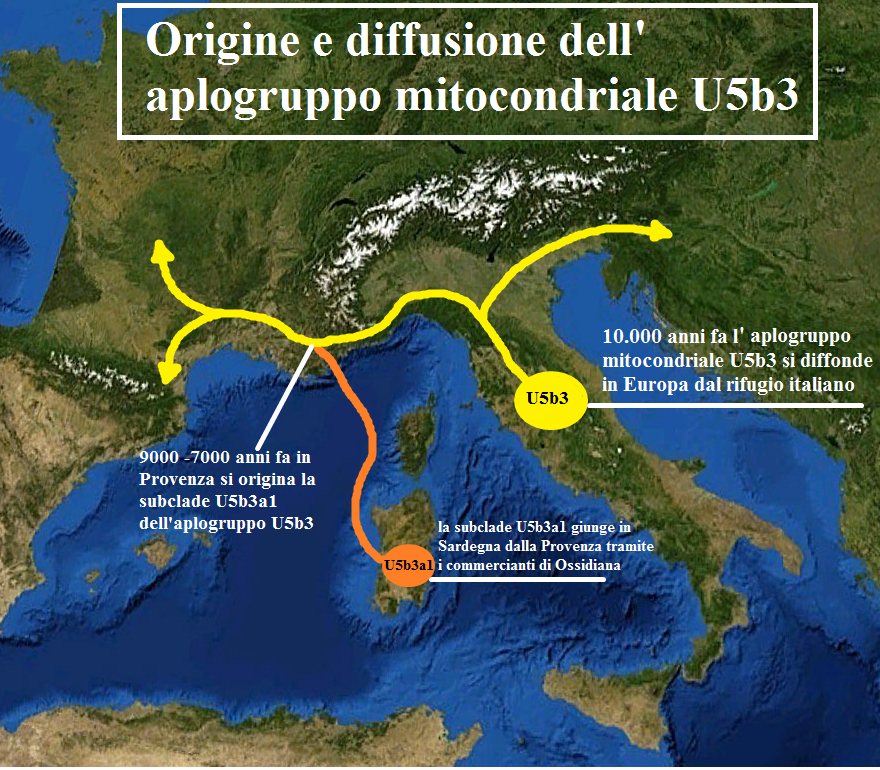"U5b haplotypes are thus present in 9 out of 16 Mesolithic
sites with genetic information available (56.3%), comprising
12 of the 27 individuals so far analyzed (44.4%). This surprisingly
widespread presence of U5b includes present day
Lithuania (Donkalnis and Kretuonas sites), Poland (Dudka
site), Germany (Hohlenstein-Stadel and Falkensteiner Ho¨ hle
sites), likely Luxembourg (Reuland-Loschbour site) and
England (Gough’s Cave), and Spain (Figure 4).
It is generally accepted that the most ancient European
mitochondrial haplogroup, U5, arose in Europe [6]. The
coalescence time estimate from molecular data for the U5 is
w25–30 thousand years (ky) and for its subhaplogroups
U5a and U5b w16–20 and w20–24 ky, respectively [35]. The
time estimate for U5b1c is 12.8 ky [35]. U5 haplotypes
are also found in Neolithic and present day populations,
although their frequency is moderated as compared to the
Mesolithic, ranging from about 1% in some places along
the Mediterranean up to 5%–8% in continental Europe [14].
The exceptions to this trend are the Saami populations, in
northern Scandinavia, where haplogroup U5 (and mainly
subhaplogroup U5b) ranges from 26.5% to 56.8%, depending
on the population [36].
,,,
Ancient genomics from Neolithic individuals from Scandinavia
[18] supports that the spread of agriculture into Europe
involved the expansion of populations from the Middle East
that eventually assimilated the contemporaneous huntergatherers.
Modern European populations seem to derive
essentially from those Neolithic migrants [18]. Until now,
however, the genetic affinities of the Mesolithic populations
to the modern Europeans were largely unknown. Our partial
La Bran˜ a 1 and 2 genomic data show that modern Iberian populations
are not descendants of the local hunter-gatherers
inhabiting the same region prior to the arrival of farmers and
thus support a genetic shift in that region between the Mesolithic
and modern populations."
http://biologiaevolutiva.org/jbertr...014/11/JB2012-312-Sanchez-Quinto-CurrBiol.pdf
Palaeolithic DNA from Eurasia
Switzerland Grotte du Bichon M
13,560–13,770 cal. BP I2a U5b1h Mutations with respect to the Reconstructed Sapiens Reference Sequence: 146T, 150T, 152T, 195T, 247G, [384G not found], 769G, 825T, 1018G, 2758G, 2885T, 3197C, 3594C, 4104A, 4312C, [5656G non found], 7028C, 7146A, 7256C, [7521G not found], 7768G, 8468C, 8655C, 8701A, 9477A, 9540T, 10398A, 10664C, 10688G, 10810T, 10873T, 10915T, 11467G, 11914G, 12308G, 12372A, 12705C, 13105A, 13276A, 13506C, 13617C, 13650C, 14182C, 16129G, 16187C, 16223C, 16230A, 16270T, 16278C, 16311T, 16519T Jones 2015






 pa covek ne zna sta je mislio
pa covek ne zna sta je mislio